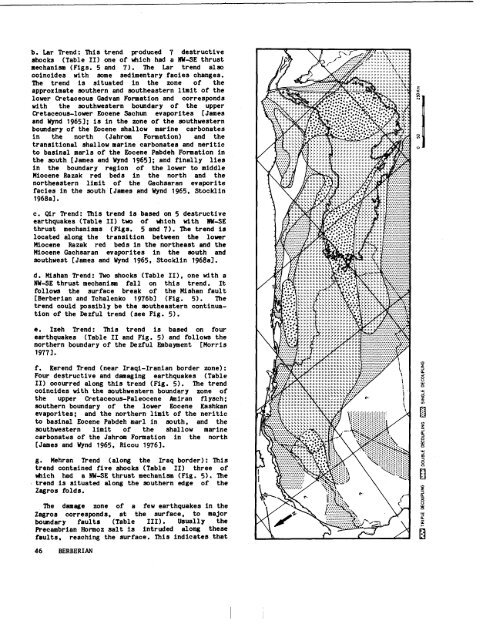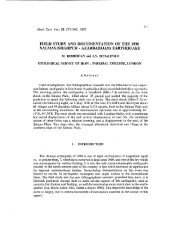PDF COPY - Manuel berberian
PDF COPY - Manuel berberian
PDF COPY - Manuel berberian
You also want an ePaper? Increase the reach of your titles
YUMPU automatically turns print PDFs into web optimized ePapers that Google loves.
, Lar Trend: ~his trend produced destructive<br />
shocks (Table II) one of which had a NN-SE thrust<br />
mechani-~m (Figs. 5 and 7). ~he Lar trend also<br />
coincides with some sedimentary facies changes.<br />
The trend is situated in the zone of the<br />
approximate southern and southeastern limit of the<br />
lo~er Cretaceous Gadvan Formation and corresponds<br />
with the southwestern boundary of the upper<br />
Cretaceous-lo~er Eocene Sachun evaporltes [James<br />
and Nynd 1965]; is in the zone of the southwestern<br />
boundary of the Eocene shallow marine carbonates<br />
in the north (Jahrom Formation) and the<br />
transitional shallow marine carbonates and neritto<br />
to basinal marls of the Eocene Pabdeh Formation in<br />
the south [James and ~ynd 1965]; and finally lies<br />
in the boundary region of the lower to middle<br />
Nloeene Razak red beds in the north and the<br />
northeastern limit of the Gaohsaran evaporite<br />
facies in the south [James and Wynd 1965, Stoeklin<br />
1968a].<br />
c. Qlr Trend: This trend is based on 5 destructive<br />
earthquakes (Table II) t~o of which with h~-SE<br />
thrust mechanisms (Figs. 5 and 7). The trend<br />
located along the transition between the louer<br />
Miocene Razak red beds in the northeast and the<br />
Mlocene Gachsaran evaporltes in the south and<br />
southwest [James and Nynd 1965, Stocklln 1968a].<br />
d. Mishan Trend: T~o shocks (Table If), one with<br />
NN-SE thrust mechanism fall on this trend. It<br />
follo~s the surface break of the Mishan fault<br />
[Barbarian and Tchalenko 1976b] (Fig. 5). The<br />
trend could possibly be the southeastern continuation<br />
of the Dezful trend (see Fig. 5).<br />
e. Izeh Trend: This trend is based on four<br />
earthquakes (Table II and Fig. 5) and follow the<br />
northern boundary of the Dezful ~nbayment [Morrls<br />
1977].<br />
f. Kerend Trend (near Iraqi-lranlan border zone):<br />
Four destructive and damaging earthquakes (Table<br />
II) occurred along this trend (Fig. 5). The trend<br />
coincides ~th the southwestern boundary zone of<br />
the upper Cretaceous-Paleocene ~mlran flyech;<br />
southern boundary of the io~er Eocene Kashkan<br />
evaporltes; and the northern llmlt of the nerltlc<br />
to baslnal Eocene Pabdeh marl in south, and the<br />
southwestern limit of the shallow marine<br />
carbonates of the Jahrom Formation in the north<br />
[James and Wynd 1965, Rteou 1976].<br />
g. Mehran Trend (along the Iraq border): This<br />
trend contained five shocks (Table II) three<br />
which had a NW-SE thrust mechanism (Fig. 5). The<br />
¯ trend is situated along the southern edge of the<br />
Zagros folds.<br />
The damage zone of a few earthquakes in the<br />
Zagroa corresponds, at the surface, to major<br />
boundary faults (Table III). Usually the<br />
Precsmbrlan ~ormoz salt is lntruded alor~ these<br />
faults, reaching the surface. This indicates that<br />
46 BERBERIAN







